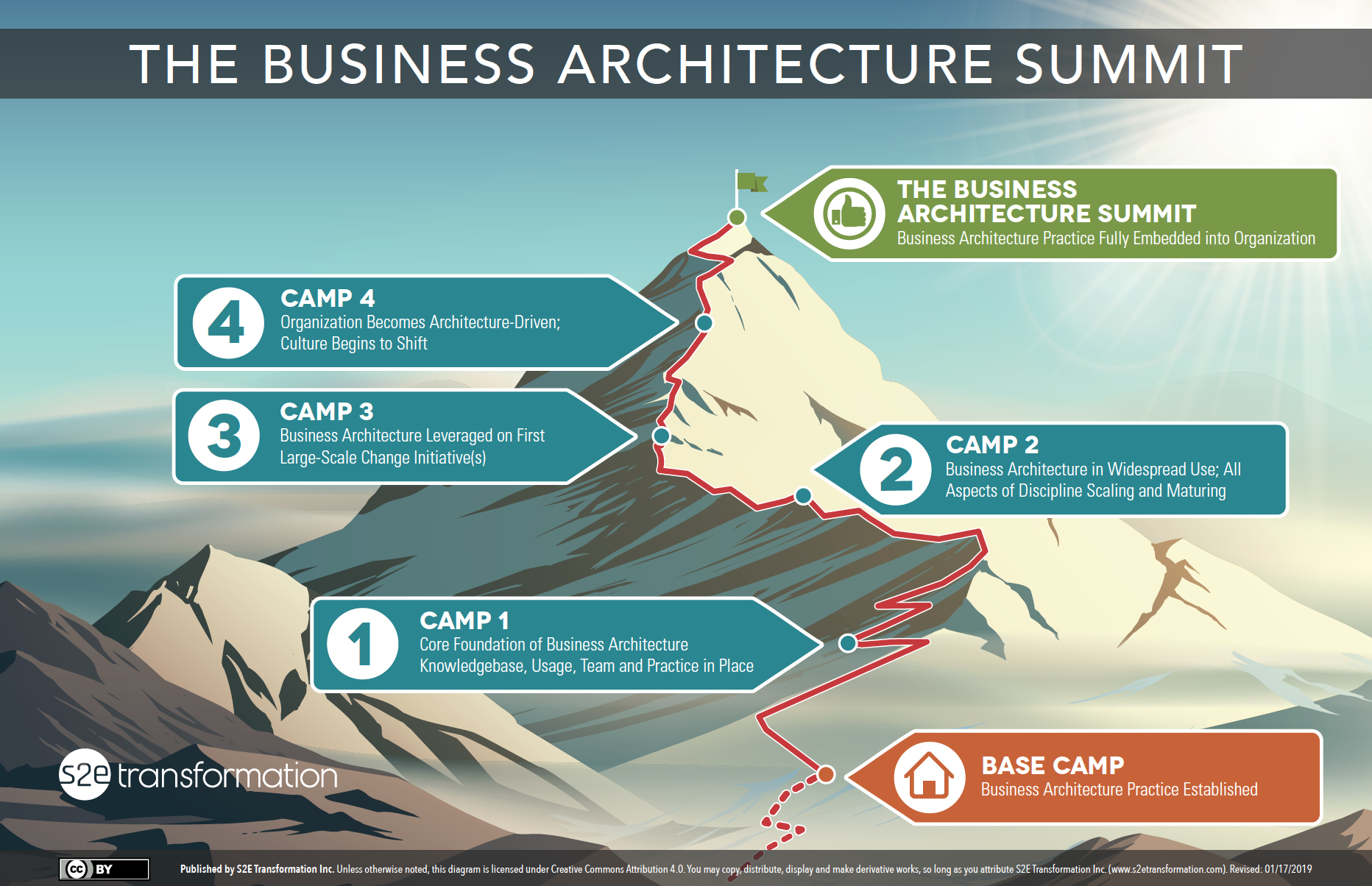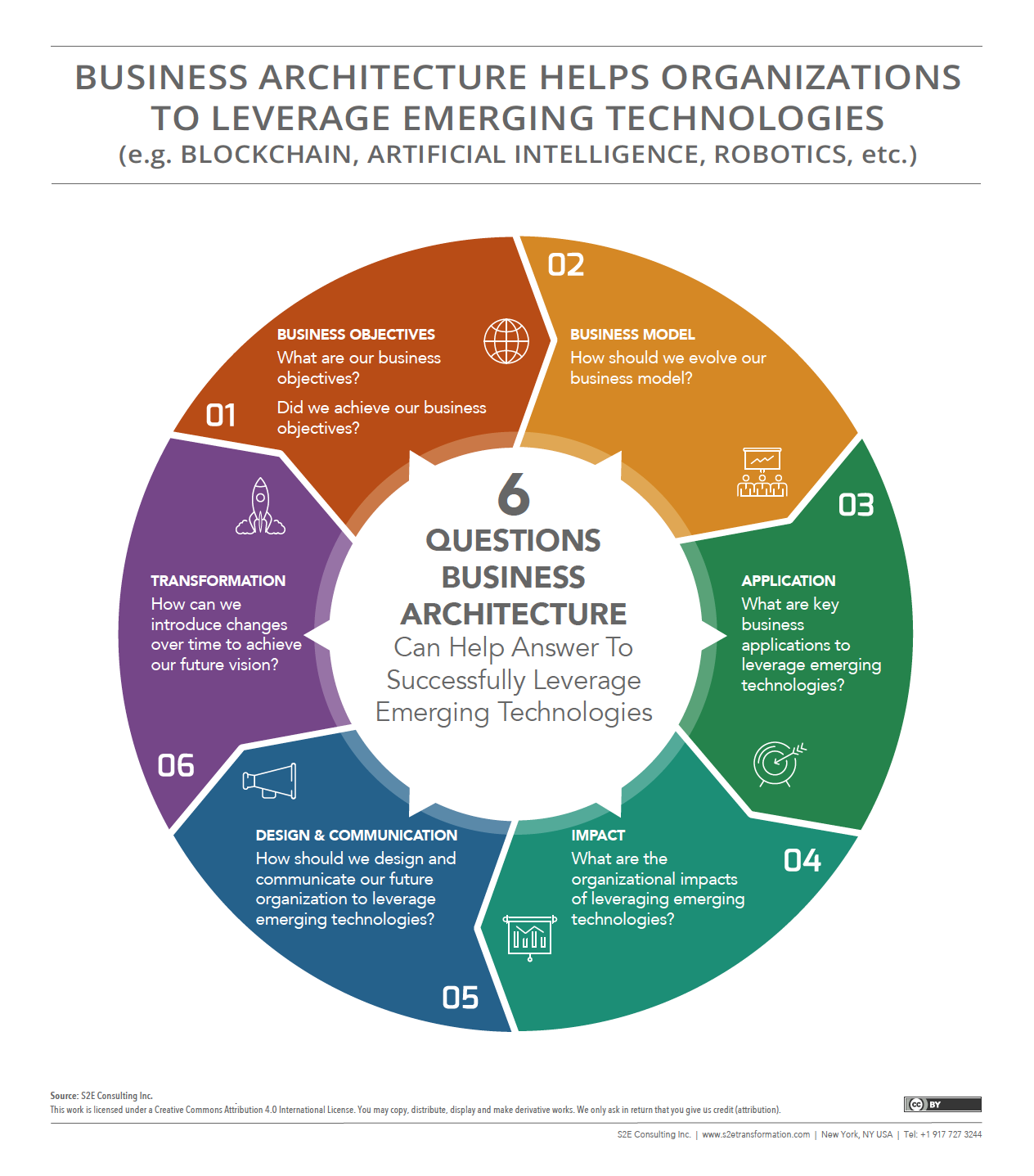![]() Having a clear vision of what we are working towards is essential to guide and inspire any journey, so in this installment of StraightTalk, we explore a concept for what it means to be a mature business architecture practice, and how to get there. In other words, if we climb this business architecture mountain, what’s at the top and what are we to expect along the way?
Having a clear vision of what we are working towards is essential to guide and inspire any journey, so in this installment of StraightTalk, we explore a concept for what it means to be a mature business architecture practice, and how to get there. In other words, if we climb this business architecture mountain, what’s at the top and what are we to expect along the way?
What does business architecture maturity mean?
Business architecture maturity is the concept of assessing and scoring (typically from level 1 to level 5) an organization’s business architecture practice across various dimensions to understand how their business architecture, team, and practice stacks up against industry standard criteria and best practices.
The Business Architecture Maturity Model™ (BAMM™) is an excellent framework to use. In the BAMM™, the maturity levels break down like this:
- Level 1 – Not happening
- Level 2 – Performed ad-hoc
- Level 3 – Performed consistently (that means across the entire enterprise, which is not necessarily easy to achieve)
- Levels 4 and 5 – Business architecture is used strategically and embedded into the fabric of the organization
StraightTalk Post No. 20 has you covered on the topic of business architecture maturity and maturity-driven practice planning, so take a look before you read on.
Why do we care about business architecture maturity?
Some organizations do care about how they perform in comparison to others, especially competitors since business architecture can be a competitive advantage for strategy execution (a.k.a. whoever gets their great ideas into actions first, wins).
However, the critical reason for assessing and deliberately working to improve an organization’s business architecture maturity is value. The greater the maturity a business architecture practice has, the higher the value it will deliver to the organization. What type of value? Indeed better results from strategy to execution (more on this idea in Post No. 3), but the rest of the answer lies in the specific value propositions that an organization has established for itself in leveraging business architecture. Some organizations focus on transformation, some focus on better investment decision-making, others focus on simplification, and the list goes on – so the answer is found from within. (BTW, organizations should establish their business architecture value proposition right from the start, as discussed in Post No. 4.)
Does a business architecture practice have to be mature before it can provide value to an organization?
Nope. Performing any business architecture activities can add value right from the start. For example, even if you are just starting to establish your business architecture knowledgebase, defining your organization’s capability map and business vocabulary can bring people together in new ways and give them new insights about the organization and what each other does.
As maturity increases though, the value provided also increases as a function of having more information in the business architecture knowledgebase, more skilled and recognized business architects, more involvement within the organization, and the ability to scale to meet all of the demand for business architecture.
Okay, so what’s at the top of the mountain? What does an organization look like that is fully mature?
Briefly stated, in an organization that is fully mature:
- The defined value proposition for business architecture is realized.
- Business architecture is fully embedded – it’s just the way the organization works.
- Business architecture is fully integrated into related functions, disciplines and processes across the entire strategy execution life cycle.
- Business architects are highly skilled and become trusted advisors to executives as well as business and technology team members.
- Business architecture may be leveraged for competitive advantage.
How do we get there?
Of course, there are always multiple routes to climb a mountain, but here is a typical progression that teams follow, using some mountain metaphors:
- The Trek to Base Camp – By this point, you will have a solid understanding of business architecture among your business architecture leaders and practitioners, a defined value proposition and vision for the discipline within your organization, some level of formal commitment to proceed, and a team established (even if it’s just a team of one). Some business architecture teams will have also spent time “proving” the value of business architecture to their organizations during this stage in order to get the buy-in to proceed. (This is roughly equivalent to a maturity Level 2 with some aspects of level 3.)
- Camp 1 – Camp 1 is all about putting the foundation in place so that business architecture is positioned correctly, can scale across the organization, and be used to solve increasingly complex challenges. When you reach Camp 1, you will have some structure and formality around each aspect of business architecture at an enterprise level including knowledgebase, usage, team and practice. (This is roughly equivalent to maturity Level 3.)
- Camp 2 – When you reach business architecture Camp 2, all aspects of your practice (knowledgebase, usage, team and practice) will be scaling and maturing further to meet the needs of the organization. You will also likely shift your focus more to the widespread usage of business architecture for a variety of business scenarios, especially since less energy is needed to socialize and establish the business architecture practice at this point. (This is roughly equivalent to maturity Level 3.)
- Camp 3 – Many organizations have a breakthrough when they take the leap and use business architecture on their first large-scale cross-business unit change initiative, such as an enterprise-wide business transformation. In such a case, business architecture (and IT architecture) facilitate cross-business unit translation of the entire scope of business direction into a comprehensive architectural vision and strategic roadmap. The resulting plan can then be executed through multiple coordinated initiatives to deliver innovative solutions over time. Such a tangible illustration demonstrates what true cross-business unit collaboration and top-down design and planning look like – versus the bottom-up, project-focused, siloed approach that is a too-often taken approach. Light bulbs go on and a new vision to what is possible emerges in peoples’ minds. After this milestone, business architecture can accelerate. (This is roughly equivalent to maturity Level 4.)
- Camp 4 – Building on the success from Camp 3, when you reach business architecture Camp 4, your business architecture team will become involved in an increasing number of large-scale change initiatives. If it wasn’t positioned there already, business architecture will rightfully take its place as a bridge between strategy and execution – upstream from initiatives. Executives may even declare that the organization is now architecture-driven. You will likely start to see an enterprise mindset for strategy execution emerge and the culture of your organization begin to shift. (This is roughly equivalent to maturity Level 4.)
- The Business Architecture Summit – As stated previously, when you conquer the business architecture summit and are standing at the top, that means business architecture is fully embedded into your organization and will be leveraged to drive critical activities such as strategy translation into solutions, business transformations, innovation, planning, decision-making, performance improvement, simplification, and business and IT alignment. (This is roughly equivalent to maturity Level 5.)
Here is a visual summary of our route to the business architecture summit:
What are some key challenges we may encounter along the way?
Here are a couple key ones business architecture teams encounter that can prevent their organizations from reaching the summit:
- Getting stuck – This can happen for a variety of reasons from a lack of understanding and buy-in for business architecture to poor execution when establishing the practice.
- Not knowing what is possible – Some teams can get stuck at Camp 2 or below – and may not even realize it. In these cases, they are still delivering much value to the organization – but just not the full potential of business architecture. The breakthrough that happens at Camp 3 when leveraging business architecture on the first large-scale cross-business unit change initiative is often the crucial turning point.
How can we speed up the path to business architecture maturity?
Here are a few key factors that can help to accelerate the journey:
- Know what you are doing – Experience in business architecture and how to establish a practice goes a long way to speed things up. If you are new to the discipline, find an experienced Sherpa to help.
- Organizational impetus – An organization with a clear, reliable driver for business architecture (e.g., transformation or regulatory challenges) will be able to achieve more acceptance and pull for the discipline because people are more receptive to trying something different.
- Organizational readiness – An organization that has or is developing a certain mindset, values, and culture is more likely to embrace business architecture. For example, when people start to focus more on cross-business unit coordination, enterprise optimization, and bigger-picture thinking, then business architecture is more likely to be welcomed.
However, don’t forget to enjoy the journey. You chose to embark on this business architecture journey – knowing that it would not be easy – because you are a person that wants to make a difference in your organization and continue to evolve as a professional. The business architecture journey will test you, change you, and in the end enable both your organization and you personally to reach new heights.
“Somewhere between the bottom of the climb and the summit
is the answer to the mystery why we climb.” — Greg Child
More Good Stuff…
Conquering the Business Architecture Summit (S2E white paper): If you’re new to StraightTalk and haven’t seen this one yet, this passion piece expands upon this post to share a vision of what is possible for a business architecture practice and some wisdom on how to get there, using a mountain as the metaphor.
The Business Architecture Maturity ModelTM (Business Architecture Guild®): You can learn about the Business Architecture Maturity ModelTM (BAMMTM) in Section 3.9 of the BIZBOK® Guide. You can access its content in the textual format in Appendix B.3 or in an editable format with scoring by downloading it from the Business Architecture Guild® Store.
Business Architecture Predictions (S2E Tool): More visionary stuff. What does the future hold for business architecture? Here is a summary of predictions and trends for the practice.
The Business Architecture Practice (S2E White Paper): If you’re new to StraightTalk and haven’t seen this one yet, this white paper provides a comprehensive overview of practical approaches to establish and mature your internal business architecture practice.
The Business Architecture Team (S2E white paper): If you’re new to StraightTalk and haven’t seen this one yet, this white paper covers a lot of details on the business architect role and team – the most important aspect of your business architecture practice.
Best Mountain Quotes To Inspire the Adventure In You (Adventure In You): Just for fun. Wisdom on life from the mountains.
What Adults Can Learn From Kids (TED Talk): Speaking of maturity, check out this smart and powerful talk by child prodigy Adora Svitak, who encourages the world to embrace more “childish” thinking: bold ideas, wild creativity and especially optimism. We second that.


